Related Research Articles
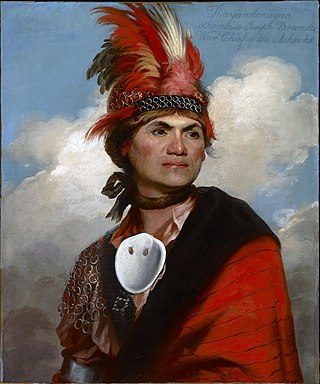
The Mohawk people are the most easterly section of the Haudenosaunee, or Iroquois Confederacy. They are an Iroquoian-speaking Indigenous people of North America, with communities in southeastern Canada and northern New York State, primarily around Lake Ontario and the St. Lawrence River. As one of the five original members of the Iroquois League, the Mohawk are known as the Keepers of the Eastern Door – the traditional guardians of the Iroquois Confederation against invasions from the east.
The Oka Crisis, also known as the Kanehsatà:ke Resistance, was a land dispute between a group of Mohawk people and the town of Oka, Quebec, Canada, which began on July 11, 1990, and lasted 78 days until September 26, with two fatalities. The dispute was the first well-publicized violent conflict between First Nations and provincial governments in the late 20th century.

The Kahnawake Mohawk Territory is a First Nations reserve of the Mohawks of Kahnawá:ke on the south shore of the Saint Lawrence River in Quebec, Canada, across from Montreal. Established by French Canadians in 1719 as a Jesuit mission, it has also been known as Seigneury Sault du St-Louis, and Caughnawaga. There are 17 European spelling variations of the Mohawk Kahnawake.

Kanesatake is a Mohawk settlement on the shore of the Lake of Two Mountains in southwestern Quebec, Canada, at the confluence of the Ottawa and Saint Lawrence rivers and about 48 kilometres (30 mi) west of Montreal. People who reside in Kanehsatà:ke are referred to as Mohawks of Kanesatake. As of 2022, the total registered population was 2,751, with a total of about 1,364 persons living on the territory. Both they and the Mohawk of Kahnawake, Quebec, a reserve located south of the river from Montreal, also control and have hunting and fishing rights to Doncaster 17 Indian Reserve.

Alanis Obomsawin, is an Abenaki American-Canadian filmmaker, singer, artist, and activist primarily known for her documentary films. Born in New Hampshire, United States and raised primarily in Quebec, Canada, she has written and directed many National Film Board of Canada documentaries on First Nations issues. Obomsawin is a member of Film Fatales independent women filmmakers.
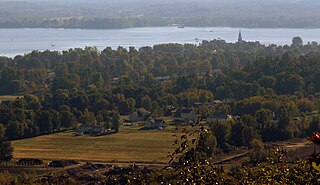
Oka is a small village on the northern bank of the Ottawa River, northwest of Montreal, Quebec, Canada. Located in the Laurentians valley on Lake of Two Mountains, where the Ottawa has its confluence with the St. Lawrence River, the town is connected via Quebec Route 344. It is located 50 km west of Montreal.
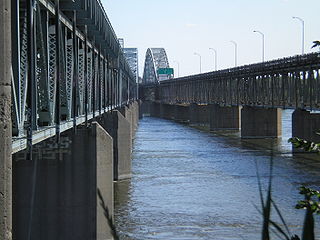
The Honoré Mercier Bridge in Quebec, Canada, connects the Montreal borough of LaSalle on the Island of Montreal with the Mohawk reserve of Kahnawake and the suburb of Châteauguay on the south shore of the Saint Lawrence River. It is the most direct southerly route from the island of Montreal toward the US border. It carries Route 138, originally Route 4. It is 1.361 km (0.846 mi) in length and contains four steel trusses on its first section. The height of the bridge varies from 12.44 m (40.8 ft) to 33.38 m (109.5 ft) with the highest sections located over the St. Lawrence Seaway. The bridge is named after former premier of Quebec Honoré Mercier.

The Company of Strangers is a 1990 Canadian film directed by Cynthia Scott and written by Scott, Sally Bochner, David Wilson and Gloria Demers. The film depicts eight women on a bus tour, who are stranded at an isolated cottage when the bus breaks down.
Kanehsatake: 270 Years of Resistance is a 1993 feature-length documentary film by Alanis Obomsawin, highlighting the events of the 1990 Oka Crisis. Obomsawin documents the events of The Siege of Kanehsatake over 78 days, capturing a rare perspective of an important turning point in Canadian history. Produced by the National Film Board of Canada, the film won 18 Canadian and international awards, including the Distinguished Documentary Achievement Award from the International Documentary Association and the CITY TV Award for Best Canadian Feature Film from the Toronto Festival of Festivals.

Billy Two Rivers was a Canadian Mohawk professional wrestler. He began wrestling professionally in 1953 and retired in 1977, having worked in the United States, United Kingdom, Japan and Canada.
Tracey Penelope Tekahentakwa Deer is a screenwriter, film director and newspaper publisher based in Kahnawake, Quebec. Deer has written and directed several award-winning documentaries for Rezolution Pictures, an Aboriginal-run film and television production company. In 2008, she was the first Mohawk woman to win a Gemini Award, for her documentary Club Native. Her TV series Mohawk Girls had five seasons from 2014 to 2017. She also founded her own production company for independent short work.

Kaniehtiio Alexandra Jessie Horn, sometimes credited as Tiio Horn, is a Canadian actress. She was nominated for a Gemini Award for her role in the television film Moccasin Flats: Redemption and she has appeared in the films The Trotsky, Leslie, My Name Is Evil, and The Wild Hunt, as well as the streaming television horror series Hemlock Grove and the sitcoms 18 to Life, Letterkenny and Reservation Dogs.
Joseph Tehwehron David (1957–2004) was a Mohawk artist who became known for his role as a warrior during the Oka Crisis in 1990.
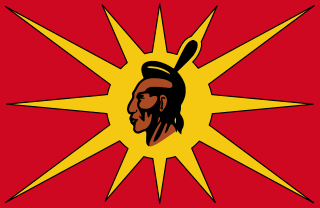
The Rotisken’rakéhte, also known as the Mohawk Warrior Society and the Kahnawake Warrior Society, is a Mohawk group that seeks to assert Mohawk authority over their traditional lands, including the use of tactics such as roadblocks, evictions, and occupations.
Roxann (Karonhiarokwas) Whitebean is an independent film director and media artist from the Mohawk Territory of Kahnawake (Canada).
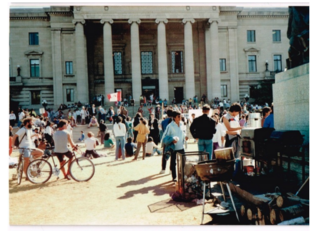
The Peace Village in Winnipeg, Manitoba, was a peace camp set up by Indigenous activists in front of the provincial Legislative Building in 1990. Established on 1 September 1990, the temporary encampment was to remain indefinitely in anticipation of a peaceful resolution to the Oka Crisis.

Beans is a 2020 Canadian drama film directed by Mohawk-Canadian filmmaker Tracey Deer. It explores the 1990 Oka Crisis at Kanesatake, which Deer lived through as a child, through the eyes of Tekehentahkhwa, a young Mohawk girl whose perspective on life is radically changed by these events.
Brittany LeBorgne is a Mohawk actress from Canada. She is most noted for her role as Zoe in the television series Mohawk Girls, for which she received a Canadian Screen Award nomination for Best Actress in a Comedy Series at the 4th Canadian Screen Awards in 2016.
Karoniaktajeh Louis Hall was an Indigenous American artist, writer and activist of the Kahnawake Mohawk Territory. He is most widely known for his design of the "Mohawk Warrior Flag", also known as the "Unity Flag", that was used as a symbol of resistance by the Rotisken’rakéhte, or Mohawk Warrior Society, in the 1990 Oka Crisis. Hall is known for being a strong participant in the reviving of the Haudenosaunee (Iroquois) spiritual traditions and Kanonsiononwe (Longhouse) culture. Hall was an expert on the Kaianera'kó:wa, the Iroquois Confederacy constitution, and was a pivotal part of the establishment of the Ganienkeh Mohawk Territory.
References
- ↑ "Obomsawin tells story of Kahnawake". Sault Star , June 23, 2000.
- ↑ "Film rocks media's view of standoff: Rocks At Whiskey Trench recasts Mohawk blockade". Kingston Whig-Standard , June 20, 2000.
- ↑ "Film recalls painful Canadian event". Sudbury Star , September 23, 2000.
- ↑ "An ugly moment in a bad summer: Rocks at Whiskey Trench shows mob stoning cars of fleeing Mohawks during Oka Crisis". Montreal Gazette , October 27, 2000.
- ↑ "Maelstrom storms the Genies". The Globe and Mail , December 13, 2000.